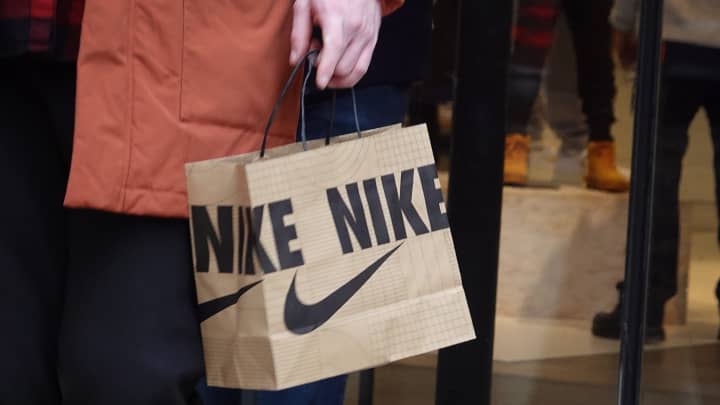
reported revenue Thursday that fell short of Wall Street's sales expectations for the first time in two years, but it beat on earnings and gross margin estimates, sending its stock soaring in after-hours trading.
Here's how the sneaker giant performed during its fiscal first quarter compared with what Wall Street was anticipating, based on a survey of analysts by LSEG, formerly known as Refinitiv:
The company's reported net income for the three-month period that ended August 31 was $1.45 billion, or 94 cents per share, compared with $1.47 billion, or 93 cents per share, a year earlier.
Sales rose to $12.94 billion, up about 2% from $12.69 billion a year earlier. Revenue for the quarter was just shy of the $12.98 billion analysts had expected, according to LSEG.
Nike shares rose about 8% in extended trading Thursday.
The retailer maintained its full-year guidance of revenue growth in the mid-single digits and gross margin expansion of 1.4 to 1.6 percentage points.
"We're closely monitoring the operating environment, including foreign currency exchange rates, consumer demand over the holiday season, and our second half wholesale order book," said finance chief Matthew Friend on a call with analysts.
"We are cautiously planning for modest markdown improvements for the balance of the year, given the promotional environment," he added.
For the second quarter, Nike expects revenue growth to be up slightly versus the prior year and gross margins to grow by about 1 percentage point versus the prior year.
Investors have been laser focused on Nike's recovery in China, its relationship with its wholesale partners and how the will impact sales.
They're also keen to see Nike's margins recover after bloated inventories, high promotions and supply chain woes contributed to lower profits over the last few quarters.
During the quarter, Nike's gross margin fell about 0.1 percentage points to 44.2%, but it was higher than the 43.7% analysts had expected, according to StreetAccount. The company attributed the gross margin drop to higher product costs and currency exchange rates, but those trends were offset by price increases, which contributed to the earnings beat.
Sales in China grew by 5% compared to the year-ago period to $1.7 billion, which fell short of the $1.8 billion analysts had expected, according to StreetAccount.
During the ended May 31, Nike saw China sales jump 16% compared to the year-ago period. But the numbers were against easy comparisons because the region was still under Covid-related lockdown orders during the prior year.
While Nike remains bullish on China, the region's economic recovery has so far been a mixed bag. Following a sluggish July, during the month of August to rise 4.6% compared to the prior year, beating expectations of a 3% growth forecast by Reuters.
"We feel good about the market there and our position," said CEO John Donahoe, adding he's traveled to China twice in the last four months. "Frankly, a couple things stand out. One, sport is back in China, you can just feel it, and that gives us great confidence about the future and the Chinese consumer in our segment, regardless of the macroeconomic outlook there."
Nike saw sales jumps in every region besides North America, its largest market by revenue. Sales in North America fell 2% from the year-ago period to $5.42 billion, just above the $5.39 billion analysts had expected, according to StreetAccount.
In Europe, the Middle East and Africa, sales were up 8% at $3.61 billion. That compared with the $3.51 billion analysts had expected. Sales in its Latin America and Asia Pacific unit came in 2% higher at $1.57 billion, just shy of the $1.59 billion analysts had expected, according to StreetAccount.
The Converse brand, on the other hand, fell well short of expectations for a second quarter in a row. Sales came in at $588 million, down 9% compared to the year-ago period. Analysts had expected sales to be about $660 million, according to StreetAccount.
Nike's direct channel, which includes its owned stores and its digital channel, led the retailer's growth during the quarter and was up 6% compared to the prior year. In June, the company noticed that shoppers were shifting towards its stores over its digital channels, signaling consumers are getting closer to pre-pandemic shopping habits.
"We continue to see that consumers want to connect directly and personally with our brands and in fact, member engagement within our direct business is up double digits versus the prior year with increasing average order values," said Friend.
"Our stores delivered an especially strong quarter with traffic up double digits from last year, and members driving an increasing share of our business as consumers shifted from our digital to physical channels... Our team was nimble in transitioning inventory to capture higher full-price sales across our entire store fleet," he said.
When it comes to its wholesale revenues, Nike's relationship with those partners have been rocky. As the company has pivoted to a direct-to-consumer model, it has focused on driving sales online and in its stores at the expense of its wholesale accounts.
However, as Nike grappled with excess inventories throughout 2023, it relied on those partners to move through that merchandise. It has now restored its relationship with both and – accounts that it previously cut in favor of its DTC strategy.
Some analysts expected Nike's wholesale revenue to be sluggish during the quarter because excess inventories have been a problem – and some wholesalers are being more particular in what they order to avoid another backlog.
Wholesale revenue during the quarter was flat compared to the year-ago period at $7 billion.
Both Donahoe and Friend made it clear to analysts that Nike is ready to meet customers in all channels — including through wholesalers and directly. The retailer shouted out as one of its key partners and noted that it's still in the process of resetting its business with , which has seen two quarters in a row of plunging sales and profits.
Despite the shift in how it's working with wholesalers, Nike insisted that direct sales will pave the way to its future growth.
"Ultimately, we have a segmented portfolio of strong partners across price points and channels. With no single partner representing more than a mid-single digit of Nike's total business," said Friend.
"While the ultimate landing spot of digital and direct isn't as clear, we do believe we're going to be a more direct and a more digital company, and a more profitable company," he said. "And there's a channel mix and channel profitability opportunity that comes with that as well."
Meanwhile, inventories fell 10% to $8.7 billion. The drop was driven by a decrease in units but offset by product mix and higher manufacturing and production costs.
"On the whole, we're very comfortable with the level of inventory in the marketplace in relation to the retail sales that we're seeing as we begin increasing levels of wholesale sell in our second half," said Friend.
Amid decades-high inflation rates, consumers have been . With the resumption of student loan payments looming ahead, some analysts expect those sectors to take an even greater hit.
Jefferies conducted a survey on U.S. consumer spending and found 54% of respondents plan to spend less on apparel and accessories. Meanwhile, 46% plan to spend less on footwear, which doesn't bode well for Nike.
It's still too early to gauge the impact of student loan payments on Nike. Its first quarter ended in late August, and payments aren't set to resume until October.
During the quarter, footwear sales rose 4% to $8.4 billion, making up about 68% of Nike's total sales. Apparel was down 1% at $3.4 billion.
Correction: Nike's gross margin fell 0.1 percentage points. An earlier version of this story misstated that figure.



